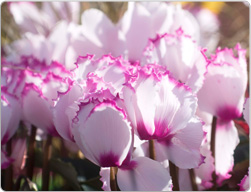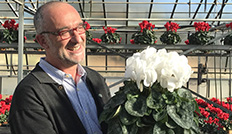 Professional area | Diseases factsheet | Fungi | Gloeosporium cyclaminis
Professional area | Diseases factsheet | Fungi | Gloeosporium cyclaminis
Gloeosporium is a soil fungus and causes anthracnose (dark pitting) in cyclamen. In Europe this is a major disease.
The attacks centre on the heart of the plant.
Young buds and young leaves wither at the tip as if scorched; stalks swell up like bottles.
Circulation in the plant is blocked, and the mature leaves are enlarged.
Mild and humid conditions encourage fungus spore formation and the spread of the disease.
There are chemical controls, for prevention and for treatment. Control of winged insects, which can carry the disease, is another preventive weapon.
The genus Gloeosporium belongs to the class Adelomycetes (also known as Deuteromycetes, or Imperfect fungi); these are fungi with septate mycelium, which are not at present known to reproduce sexually. Within this class, Gloeosporium belongs to the family of the Melanconiaceae in the order Melanconiales. The conidia or spores of this genus are produced under the cuticle of the host plant within a body of mycelium. For the spores to be released, then, the epidermis or cuticle of the plant has to be torn.
Gloeosporium cyclaminis (syn. Cryptocline cyclaminis) is a disease of cyclamen. It is a soil fungus, which has most effect at flowering time; it causes anthracnose disease, a cryptogamic malady. Anthracnose is on the increase again just recently, even though it was identified and the organism isolated as early as 1922. For cyclamen growing in Europe this is a disease of major importance and can cause a very significant amount of damage.
It is the heart of the plant above all that the site of the onslaught; and for this reason its spread may pass unnoticed for a while.
It is especially the floral buds that are invaded. In an attack the young buds stop developing, remaining small, bent, distorted and dried up as if scorched. About 1 or 2cm down from the flower, there is a rapid drying up of these very juicy stems; the base remains healthy, but the stalk loses it toughness and can be broken by the slightest jar, and blooming is aborted. Sometimes the necrosis does not go so far, and the stalk suffers only a check to growth on one side, being thereafter bent and distorted.
The flowers wilt and there is a dry discoloration of the tissue, to blackish chestnut. Flowers that are still opening show brown stains on the whorl (corolla) which remains crumpled and withers. Flowers that are already out show the attacks by wilting around the base.
On contact with the flowers, the young leaves in the heart of the plant also wilt and their tissue takes on a dry chestnut-coloured aspect. Thus the heart of the plant is emptied. Small leaves that form will be distorted, curling up at the edges.
On the margins of older leaves there is a noticeable wilting, again accompanied by a chestnut discoloration; these leaves are bound to wilt away entirely in the end. The leafstalks themselves may become deformed and bottle-shaped.
There is no outward manifestation of tuber attack; but inside the vessels turn a blackish chestnut colour. The same siting of this discoloration may be observed in the stalks as well.
On the stalks that are still green, and on the dried-up buds that fall to the ground, or even on the petals and leaves, coloured depressions (pits) form, and this is where the fungus’ fruiting bodies appear, forming chestnut-coloured or orange spore masses.
Symptoms of Gloeosporium cyclaminis attack are easy to confuse initially with Cyclamen Mite (Tarsonema) infestation.
There is another fungus which also causes anthracnose attacks with symptoms resembling those of Gloeosporium cyclaminis. This is Glomerella cingulata, the Imperfect form of which is known as Colletotrichum gloeosporioides. This Imperfect form often attacks plants, and causes small round spots of a chestnut colour, which are themselves hard to distinguish from those caused by the viruses INSV and TSWV. In order to tell anthracnose from viral attack it is necessary to examine the surface of the spots. In the case of the fungus spore masses, more or less orange in colour, are produced.
Due to the great number of spores produced (orange spores visible on dead tissue after an attack), each cyclamen plant infected can be an extremely potent source of further infection. The spores can be spread by insects present in the glasshouse, by water and on the wind; the main dissemination takes place above ground.
This fungus is also capable of surviving in the soil for almost two years.
Growth and spread of Gloeosporium cyclaminis is fairly well controlled by preventive measures; but action must be taken early, for the damage done is irreparable.
However it is beginning to look as if this pathogen is making a comeback because of the emergence of strains that have resistance to benzimidazole chemicals.
The disease develops mostly in warm and humid conditions. In order to curb attacks, it is therefore necessary:
Intervene as soon as possible, against winged insects as well as against the fungus, for these can be vectors.
The constant development of the regulations and homologations of phytosanitary treatment products, and the differences in regulations according to each country make it impossible for us to include updated information on homologations. Each producer will have to contact his local plant protection bureau to obtain the latest updates concerning the regulations and use of phytosanitary products. We strongly advise testing beforehand on a plant sample in order to measure the chemical’s activity (establishing the dose) and any effect on the plant (plant poisoning).
This advice sheet is based on the methods used at the SCEA at Montourey (Fréjus, France). These procedures may need some modification to adapt them to other climatic situations. Before starting to grow cyclamen there needs to be a review of precautions against pests and diseases. We must point out that our advice and suggestions are offered for information purposes and therefore cannot include any guarantee of specific results; it is a good idea to carry out trials beforehand.

2565, rue de Montourey
83600 Fréjus - France
International telephone : +33 (0)4 94 19 73 04
Switchboard : + 33 (0)4 94 19 73 00
Fax : +33 (0)4 94 19 73 19

